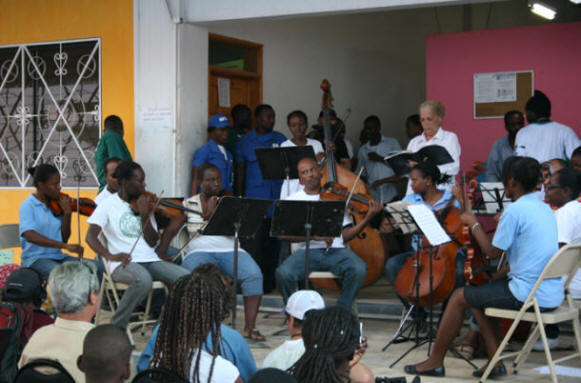Orchestras of the Americas for Social Inclusion_Organization of American States

Reaching into Haiti's Cultural Past to Lift its Future
OAS Press release
The people of Haiti have inherited a vibrant culture rooted in three continents—America, Europe and Africa—that continues to lift their spirit through good and bad times. This is the cultural legacy the Organization of American States (OAS) sought to take advantage of when it launched its Orchestra Program for Youth at Risk in the Caribbean out of the École de Musique Sainte Trinité in Port-au-Prince.
The OAS has had a presence in Haiti for more than half a century, leading efforts related to democracy and civil participation, and supporting various initiatives in the area of development. But this year for the first time the OAS began to reach into the country’s lively cultural heritage implementing a cultural program of social inclusion of youth through music.
Shortly before the January 12 earthquake that devastated the country’s capital, the OAS youth orchestra program had recruited more than 80 youths between 10 and 18 years of age, considered at risk of dropping out of school and entering a life of violence. After the earthquake, significant efforts have been made to restart the program, despite the fact that the building of the school of music Sainte Trinité in which the students were taught completely collapsed.
On February 5, the École de Musique Sainte Trinité, together with the OAS and Viva Rio, a Brazilian non-governmental organization working in Haiti, united hands to support the participants and offered a music recital in Bel Air, Port-au-Prince. It was the first time since the earthquake that the Philharmonic Orchestra of Haiti and the children’s choir Les Petits Chanteurs had performed, and they used some of the instruments recovered from the rubble of the school’s collapsed building. The goal of the concert was to lift the people’s spirit, but it was also an opportunity for the OAS to try to relocate and regroup some of the students of its successful musical program. A week later the musicians also played at a ceremony held to honor the victims of the earthquake attended by diplomats and representatives of the Haitian government.
As a result of the earthquake, many students were displaced and, for that reason, the OAS, in partnership with Viva Rio and the École de Musique Sainte Trinité, is currently seeking to enlist new at-risk youth and relaunch its Youth Orchestra Program in March in a tent on the school’s lot. Music instruction will be offered Monday to Friday for two hours a day.
Based on Venezuela’s publicly financed music education program known as El Sistema, the OAS youth program seeks to address Haiti’s youth violence and high dropout rates. Bel-Air and later Cité Soleil are the target neighborhoods for the program. “The objective is always the concert,” explained Mariano Vales, Coordinator of Musical Programs for the Department of Cultural Affairs of the OAS and conductor of the youth program’s orchestra and choir. “The objective is not to develop a perfect ability to play a musical instrument but to perform and be applauded for it. The community has a fundamental role in this because its involvement is necessary, and in many cases it happens that the concert becomes the only artistic event in the community, and so it becomes a source of pride for the community, for the parents, and for the children who participate.”
According to a 2007 report by the Inter-American Development Bank, El Sistema has been the source of many important social benefits related to a reduction in school dropout rates and victimization rates in the Venezuelan communities where it operates. For example, the report states that school dropout rates among children and youth involved in El Sistema were much lower than among those in a control group: 6.9 percent versus 26.4 percent. Also, a much higher number of those involved in El Sistema participated in community activities (60.1 percent versus 37.9 percent) and in the labor force (40.7 percent versus 12.5 percent).
“Parents report substantial improvements in their children’s punctuality, responsibility and discipline after going through El Sistema,” the report also notes. This is the positive impact the OAS seeks from its youth program in Haiti.
To achieve that goal the OAS youth program employed seven teachers and one coordinator who taught the students string instruments—violins, violas, cellos, basses—and song in a group setting for two hours a day, five days a week. As part of this training, the students learned a variety of musical forms, including those native to their own country. Some of the program’s specifics are currently being reworked to adapt to post-earthquake conditions and resources.
The OAS Youth at Risk Program, also known as OASIS-Caribbean, is also being implemented in Jamaica and Saint Lucia, countries that also have experienced high rates of youth violence and crime. Jamaica has the highest rate of convicted juveniles per day: 7.1 per 100,000 inhabitants, according to World Bank and United Nations reports. Saint Lucia, on the other hand, has the highest youth unemployment rate in the Caribbean.
The youth program, hopes to attract more private funding to be expanded to other countries in the future, but first it is to be implemented in its current form for three years before its results are formally evaluated and a manual of best practices elaborated. Funding for the program comes from the OAS Fund for Technical Cooperation (FEMCIDI); Yéle Haiti, a grassroots movement founded by Grammy-Award winning musician Wyclef Jean; LUCELEC, the Saint Lucia power company; and the governments of China and Colombia.

- June 23, 2011
OAS Orchestra Program takes part of United Nations High Level Working Session
› Read all - April 14, 2011
OAS Orchestra Program at Center for Latin American and Caribbean Studies at NYU
› Read all - February 8, 2011
OAS Participates in Harvard University Panel of Experts on Music Education Policies
› Read all
Haiti Relief Efforts:
Rebuilding Sainte Trinité
The Youth Orchestra Program in Haiti experienced a major setback when the Program’s host school, the Ecole de Musique Sainte Trinité, was destroyed during the 2010 earthquake.
Since the OASIS program started, Sainte Trinité served as a venue for the disadvantaged youths of Bel-Air. If we put our efforts together we can bring back the program and help rebuild the school.
› Click here to see what we are doing and to get involved.